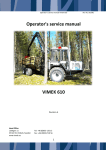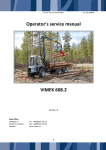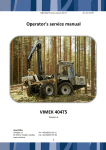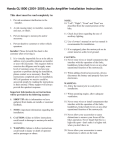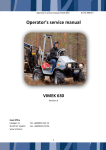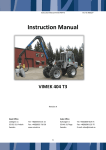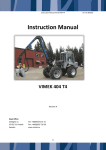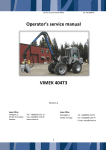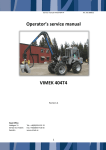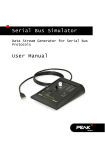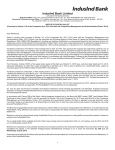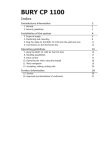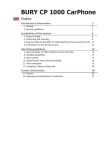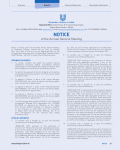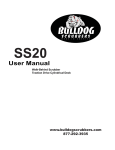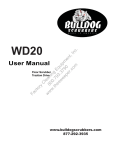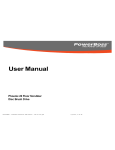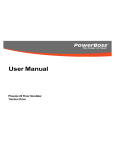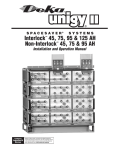Download Instruction Manual VIMEK 404 T5
Transcript
Instruction manual 404 T5 Instruction Manual VIMEK 404 T5 Revision A Head Office Lidvägen 11 SE-922 31 Vindeln, Sweden www.vimek.se Tel.: +46 (0)933-135 15 Fax: +46 (0)933-710 56 1 Art. No. 911290 Instruction manual 404 T5 Art. No. 911290 Thank you for purchasing your model of VIMEK 404 T5 VIMEK 404 T5 is designed and manufactured on the basis of our many years of experience in forestry. We are convinced that this is a good investment for you and that you will really enjoy this product from VIMEK! This instruction manual is for the VIMEK 404 T5. In addition to this instruction manual, you will also be supplied with other instruction manuals and spare parts books for the equipment you have opted to add to your machine. The instruction manuals contain the information you should know in order to handle and care for your VIMEK 404 T5 in the best possible way. Pay close attention to the content and the advice given before operating your machinery. This will provide the optimum conditions for long, trouble-free value-for-money operation. When ordering spare parts, the spare part number and machine number should also be given in order to ensure receipt of the right spare part. VIMEK conducts continuous product development and reserves the right to freely change the content of its publications, instructions and information without prior notice. Particularly important information is marked with the following symbols: Only trained and authorised personnel may use the machine. Risk of personal injury or damage to property Immediately stop any work Important information Applications The machine is, in this application, designed for clearing timber and brushwood as well as ditch cleaning with the grab bucket. The machine must be used and cared for in accordance with the instructions. It is of particular importance that the stated safety regulations are followed. 2 Instruction manual 404 T5 Art. No. 911290 Contents 1 1.1 2 VIMEK 404 T5.......................................... 4 6 Safety ............................................ 5 2.1 2.2 2.3 2.4 2.5 Identification ................................. 7 4 Technical Data ............................... 8 4.1 Oil qualities ............................................. 8 Technical Description ..................... 9 5.1 5.2 5.3 5.4 5.5 5.6 5.7 5.8 5.9 5.10 5.11 5.12 5.13 5.14 5.15 5.16 5.17 5.18 5.19 Machine .................................................. 9 Crane .................................................... 10 Harvesting unit ..................................... 10 Engine ................................................... 11 Transmission ......................................... 12 Braking .................................................. 13 Back-up/parking brake ......................... 13 Centre stabilisation ............................... 14 Heating/AC system ............................... 14 Machine Controls ................................. 15 Machine Controls EL ............................. 16 Display. ................................................. 17 Printer, converter and computer modules................................................ 18 Power socket, external, 12V ................. 18 Machine controls, crane and base machine ................................................ 19 Machine controls, harvesting unit ........ 20 Fuses, instrument panel ....................... 21 Fuses, centre console end .................... 22 Hydraulics ............................................. 23 7 In cold climates .................................... 24 Starting the Engine ............................... 24 Backward rotation ................................ 25 Stopping the Engine ............................. 25 Driving .................................................. 25 Gas controls ......................................... 26 Control ................................................. 26 Gears .................................................... 26 Parking ................................................. 26 4-wheel drive ....................................... 27 Limited Slip Differential ........................ 27 Cab Heating .......................................... 28 AC (Extra option) .................................. 28 Diesel heater (extra option) ................. 28 Off-Road Driving ................................... 28 Crane Operation ................................... 28 Transporting the Machine ............ 29 7.1 Attachment points for towing .............. 29 8 Long-term storage ........................ 29 9 Replacement parts ....................... 30 10 Scrapping ..................................... 30 11 Warranty ...................................... 31 11.1 11.2 11.3 11.4 11.5 11.6 3 Hydraulic system cleanliness................ 23 Filling with hydraulic oil ....................... 24 Driving instructions ...................... 24 6.1 6.2 6.3 6.4 6.5 6.6 6.7 6.8 6.9 6.10 6.11 6.12 6.13 6.14 6.15 6.16 General ................................................... 5 Safety Regulations .................................. 5 Fire protection ........................................ 6 Personal Safety ....................................... 6 Safety switch ........................................... 6 3 5 5.20 5.21 Introduction ................................... 4 Warranty period ................................... 31 Owner undertakings ............................. 31 Scope .................................................... 31 Labour and travelling expenses ........... 32 Materials .............................................. 32 Replacement parts ............................... 32 Instruction manual 404 T5 Art. No. 911290 1 Introduction 1.1 VIMEK 404 T5 VIMEK 404 T5 is a 4-wheel drive forwarder with optimal properties for thinning work. The machine is equipped with an effective harvester unit. Thinning can be done with a minimum of road area thanks to both its centre and wheel control as well as a width of only 1.84 m. The machine is equipped with a tested cab. Only trained and authorised personnel may use the machine. Carelessness or incorrect use of the machine may result in serious personal injury or damage to property. Read and learn the safety regulations before you begin driving the machine! 4 Instruction manual 404 T5 Art. No. 911290 2 Safety 2.1 General The rules below do not exempt the driver from complying with legislation or other applicable national regulations pertaining to safety in the workplace. Incorrect use, poor maintenance or carelessness may cause injury or damage to equipment and the environment. Therefore, it is important to study, understand and follow the instructions set out in the operator's manual. The person responsible for installing, servicing or doing anything else with the machine must have received the necessary training and be competent to perform their task. Important signs: Read the instruction manual before commissioning. 2.2 Safety Regulations The operator must undergo training under the supervision of a qualified tutor. Turn off the engine before servicing, maintenance or inspection. Always disconnect the supply voltage to the machine before starting any maintenance or service work. Do not walk under a lifted load Damaged or worn parts must be replaced immediately. Never open the cooler lid when the engine is running or has recently been stopped. Pressurised hot water in the cooling system. The danger area around the machine extends for 75 metres. When operating the machine in forests, all work must be carried out so that the machine, driver or the surroundings are not put in any danger. Extra attention should be paid if there is anybody in the vicinity of the machine. The crane is not suitable for lifting people. Ensure that the engine cannot be started unintentionally. During driving, the driver must look out for abnormal noise and leaks. Hoses and pipe components can still be pressurised even though the machine is switched off. Errors that are discovered which could lead to personal injury or damage to property must be resolved before further driving. When operating near power lines, crane work must be done with caution, and the crane should not be any closer than 6 metres from the lines. The braking function is reduced when the gearbox is in neutral and when the 4-wheel drive is disconnected. Note that the discharge of liquid from the machine can cause a risk of slipping, fire and other risks. Clean up any leaks. The centre lock is deactivated when the machine's accelerator is pressed. There is a risk of rolling over. Always clean the work area before and after servicing the hydraulic components. Running the engine must be done in wellventilated areas. There is a risk of poisoning. Ensure that the seat cannot interfere with machine operation when it is rotated. Do not mix the fuel with any other substance - risk of explosion. 5 Instruction manual 404 T5 Art. No. 911290 2.3 Fire protection The machine can be equipped with a sprinkler system. Read the accompanying instructions. Be cautious when washing and during other procedures which may damage or trigger the system. The machine comes with 2 fire extinguishers when supplied: one external and one inside the cab. The machine owner is responsible for ensuring that the applicable regulations in respect of fire protection are followed. Contact your insurance company Be extra observant for fire if the machine is equipped with chains or caterpillars. Risk of formation of sparks on stony surfaces. Fire extinguisher 2.4 Personal Safety Use ear defenders. Use suitable protective equipment when servicing. 2.5 Safety switch The machine has a safety switch which recognises when the seat is locked in position to the crane. If the seat lock is not in position, the joystick and the harvester unit will stop working. You must therefore ensure that the seat lock is engaged. Safety switch for seat bearing 6 Instruction manual 404 T5 Art. No. 911290 3 Identification The identification plate has information on the machine type, production number, production year, manufacturer, CE mark, etc. This information is important to know when ordering spare parts or in any other contact with the manufacturer where machine identity is significant. Location and appearance as below. … 7 Instruction manual 404 T5 4 Technical Data Motor Make/Model Number of cylinders Max. power/RPM Engine capacity CAT 2.2 (T) 4 36.4 or 44.7 kW 2216 cc Transmission/steering Gearbox Drive, gearbox Transmission Control Turning box, speed register 0-15 km/h Hydraulic motor Mechanical Hydraulic articulated steering and axle steering Hydraulic system Pressure Flow 220 bar Load sensing max 120l/min Volumes Oil volume, gearbox Oil volume, engine Fuel volume Hydraulic oil volume Steering axle 22 l 9l 52 l 52 l 7l Dimensions Tyres Length Width Cab roof height, inc. sprinkler Ground clearance Weight 405/70-24 (14 ply) 3350 mm 1840/2150 mm (external dimensions, drive wheel) 2.8m 400 mm Weight inc. unit, 4.1 tonnes Electrical system Voltage Battery Alternator 4.1 12V and 24V 12V-95Ah 12V 65A or 85A Oil qualities Motor Gearbox Steering axle API CG-4, CI-4 with caterpillar ECF-1 GL4, GL5, additive required for wet brakes GL5, LS supplement required 8 Art. No. 911290 Instruction manual 404 T5 Art. No. 911290 5 Technical Description 5.1 Machine The machine comprises a centrally steered tractor chassis, a crane and a cutting head. 2 1 3 6 11 4 5 10 4 4 8 9 5 1. Driver's cab 2. Crane 3. Rotator/link 4. Harvesting unit/other tool 5. Tyres 6. Bonnet 7. Point of use lighting 8. Belly guard 9. Centre link 10. Diesel tank 11. Centre stabilisation 12. Front axle 13. Condenser AC (extra equipment) 7 13 7 7 12 9 Instruction manual 404 T5 5.2 Crane See the separate instruction manual for your specific crane model. The crane identification plate is located as shown in the image below. Identification plate 5.3 Harvesting unit See separate instruction manual. 10 Art. No. 911290 Instruction manual 404 T5 5.4 Art. No. 911290 Engine The engine is a CAT brand 4 cylinder turbo diesel engine. See the separate manual for a detailed description. 3 6 4 11 12 14 1 2 13 3 9 10 7 5 1. 2. 3. 4. 5. Engine Cooler Oil filler inlet Air purifier Dipstick 8 6. Exhaust pipe 7. Oil filter 8. Alternator 9. Diesel filter 10. Starter motor 11 11. AC compressor (option) 12. Turbo 13. Diesel heater (option) 14. Battery Instruction manual 404 T5 5.5 Art. No. 911290 Transmission A hydraulic motor drives the gearbox. The power from the gearbox is transferred to the front axle via a universal shaft. The gearbox has 4 positions and a speed lever with 4 positions. These work both forwards and backwards. The direction is determined by the accelerator. The gearbox is equipped with a differential that can be locked as required. It locks the cab section wheels and is only used if the wheels slip. Note that locking the differential makes steering very difficult as doing so forces the machine to drive forwards in a straight line. The machine has engageable/disengageable 4-wheel drive. The four-wheel drive must always be engaged when working on rough terrain. Four-wheel drive should be disabled when transporting across good terrain. 12 Instruction manual 404 T5 5.6 Art. No. 911290 Braking The machine has a load holding function that brakes the transmission as necessary if the machine starts to go faster than the driver is requesting through the accelerator. 5.7 Back-up/parking brake The machine is fitted with negative brakes on the steering axle. The brakes are automatically activated when: The machine is switched off. The machine is running and the accelerator is in neutral. The brakes are automatically released when the accelerator is activated; even if the machine's gearbox is in neutral. Pressure gauge brake pressure parking/back-up brake When the pressure gauge displays 0 bar, the brakes are activated. If the accelerator is activated, the pressure gauge should show a pressure of around 20-40 bar (a pressure of at least 13 bar is needed to release the brakes). Check the pressure gauge value when you change gear. Contact service personnel if the brake pressure is incorrect. When any of the gear levers is in neutral, the hydraulic motor will not brake the machine. Avoid changing gear if the machine is on a slope. If you are forced to change gear whilst on an incline, use the crane and steering controls as extra brakes. 13 Instruction manual 404 T5 Art. No. 911290 5.8 Centre stabilisation The stabilisation cylinders' function is to counteract tipping of the machine. The centre is locked when: The machine is switched off The machine is in operation with the accelerator in neutral. The stabilisation is released automatically when the accelerator is activated. The opening pressure on the stabilisation lock must be adjusted if it does not lock or does not lock correctly. Adjustment, centre lock Extra pressure can be placed on each stabilisation cylinder by pressing on one of the stabilisation buttons with the joystick. See "machine control, crane and base machine" 5.9 Heating/AC system Safety Note that the coolant circuit is a closed, pressurised system and that installation and servicing may be carried out by accredited companies only. Operation of AC system. The climate control unit is located on the roof of the vehicle. The compartment fan blows air through two holes in the roof and is controlled by a three-step control in the user's control panel. In order to obtain cool air, the power switch is turned on and the compressor starts. Once the compressor is activated, the condenser unit on the roof also starts. Adjusting the air temperature on incoming air, to the cab, is done by adjusting the amount of hot water to the climate control unit. Start the AC system once a week even if it is not needed so as to prevent the compressor gaskets drying out. Operation of heater kit. The climate control unit is located on the roof of the vehicle. The compartment fan blows air through two holes in the roof and is controlled by a three-step control in the user's control panel. Adjusting the air temperature on incoming air, to the cab, is done by adjusting the amount of hot water to the climate control unit. 14 Instruction manual 404 T5 Art. No. 911290 5.10 Machine Controls 4 3 2 1 11 5 9 8 6 7 10 … 1. 2. 3. 4. 5. 6. Accelerator, Forwards/Backwards Left lever/pallet Right lever/pallet Computer, harvester unit Heating controls Shift box I-III 7. Gearbox 1-4 8. Pressure gauge, brake 9. Control, engine RPM 10. Connecting/disconnecting 4-wheel drive 11. Pressure relief button, hyd. motor Remember that the centre lock locks when the machine's accelerator is activated; therefore do not rest your foot on the accelerator when not in use. 15 Instruction manual 404 T5 Art. No. 911290 5.11 Machine Controls EL 15 3 9 8 6 10 11 7 13 4 5 1 2 13 14 1. 2. 3. 4. 5. 6. 7. Summer, low oil level, high temperature. Socket, 12V Work light, back Heating, green Fan speed Forward lighting Ignition lock 8. Work light, load holder 9. Work light roof, outside/side 10. Crane lighting 11. AC, ON/OFF 12. Fuse holder 13. Main switch 14. Information display 16 Instruction manual 404 T5 Art. No. 911290 5.12 Display. The display provides information on temperatures, warnings, alarms and engine speed. RPM Engine temp, at elevated engine temp, 97 degrees, the background colour of the meter changes from black to red. If the engine temperature reaches 103 degrees, an audible signal is also emitted. Hydraulic oil temp, at elevated temp, 70 degrees, the background colour of the meter changes from black to red. If the oil temperature exceeds 85 degrees, an audible signal is also emitted. Charging inoperative. Low engine oil pressure. Medium pressure filter 75% spent. If this light comes on even when the hydraulic oil has reached operating temperature, the filter should be replaced in the near future. It is normal for this light to come on when the oil is cold. Low hydraulic oil level, top up oil. RPM Speed (See the section "Throttle controls" for further information.) 17 Instruction manual 404 T5 Art. No. 911290 5.13 Printer, converter and computer modules If you have a printer installed in the machine, it is located in the cubbyhole under the instrument panel. The computer modules for the harvester unit are hidden under a protective plate. The converter for 12V to 24V for the harvester unit is located to the right of the printer. 3 1 2 1. Cover plate for computer modules 2. Printer (option) 3. Current converter 5.14 Power socket, external, 12V Under the cover plate is a 12V power socket suitable for small electric pumps and similar items. 12 V Earth 18 Instruction manual 404 T5 Art. No. 911290 5.15 Machine controls, crane and base machine The crane is operated with a 2 lever system. Functions: Control, centre Right Left Stab. Stab. Steering Tilt out Main arm lower Crane pivot Rotator Diff. Crane pivot Steering Rotator Tilt in Main arm lift 19 Instruction manual 404 T5 Art. No. 911290 5.16 Machine controls, harvesting unit This function description shows how the button functions are designated when the machine is delivered. Some buttons are programmable. The information below cannot therefore be guaranteed for all machines. Check before driving, that the functions on the buttons correspond with the expected movements on the machine. Right Left Tilt down Steering Grips open Steering Stab. Shift Limited slip differential Stab. New stem Reserve Apt. 8 Belt, upper Feed back Pruning blade, upper Pine Feed forward Saw/cut Pulp Spruce Leaf Tilt up Timber 20 Apt. 7 Module + Module Range 5 Rot Reserve (push push) Range 3 Wreck Instruction manual 404 T5 Art. No. 911290 5.17 Fuses, instrument panel 1 7 2 8 3 9 4 10 11 5 12 6 F1. Ignition ............................................ 25 A F2. Lights, rear ......................................... 15 A F3. Lights, front outer .............................. 20 A F4. Crop computer ................................. 10 A F5. Windscreen wipers/Radio .................. 15 A F6. Empty ............................................... F7. Lights, front inner ............................... 20 A F8. Crane lighting .................................. 20 A F9. Work light, load holder .................... 20 A F10. Fan ................................................ 15 A F11. AC ................................................. 20 A F12. Empty ........................................... 21 Instruction manual 404 T5 Art. No. 911290 5.18 Fuses, centre console end 13 19 14 20 15 21 16 22 23 17 18 24 F13. F14. F15. F16. F17. F18. F19. F20. F21. F22. F23. F24. Feed, relay kit ....................................... 10 A Empty ................................................... Air seat ................................................ 15 A Hydraulic oil cooler ................................ 15 A Pressure relief, gears ............................. 15 A 12V Cigarette lighter .............................. 15 A Controller ............................................. 10 A Control, electric plug ............................. 15 A 12V External socket ............................... 20 A Light, fuse holder .................................... 3 A Extra ...................................................... Sprinkler ............................................... 7.5 A 22 Instruction manual 404 T5 Art. No. 911290 5.19 Hydraulics The hydraulic system is load-sensing. The hydraulic pump sucks oil from the tank and forces the oil into the manoeuvring valve. Before the return oil goes into the tank, it is cooled as required and cleaned through a return filter. On the filter is a pressure gauge that shows the degree of filter clogging. Change the filter when the gauge indicates too high a return pressure. See the service manual 3 6 8 2 5 7 1 4 1. 2. 3. 4. Hydraulic oil tank Hydraulic pump Return oil filter Hydraulic oil cooler 5. 6. 7. 8. Valve unit Level guard Circulation pump Pressure gauge Hydraulic oils: For optimum operation and lifespan of the hydraulic system, the hydraulic oil must be designed for outside use and must work within a wide temperature range. The oil must contain additives to counteract foam, improve the film strength and reduce the viscosity's temperature dependence. We recommend an environmentally-friendly oil. The machine is supplied with oil as per the oil specification (separate document). Before using any other oil, you must also confirm with your supplier that the oils can be mixed. The quality of the new oil must be comparable with the one in the oil specification. 5.20 Hydraulic system cleanliness Hydraulic components are sensitive to contamination. Always take care to ensure that dirt or water does not get into the hydraulic system. Once a year (or every 500 operating hours), you should perform an oil analysis in conjunction with your oil supplier in order to ensure that the oil is in good condition. 23 Instruction manual 404 T5 Art. No. 911290 5.21 Filling with hydraulic oil Check the level in the hydraulic oil tank using the dip stick. The level should be 5-10cm under the maximum tank volume. The level can also be checked using the information menu on the instrument panel display. This shows 100% when the oil level is correct. When topping up oil levels, use a pump fitted with a filter. 6 Driving instructions 6.1 In cold climates In cold climates, always warm up the engine and the hydraulic system before beginning work with the machine. Run the engine on low revs and do not overload it before it has reached operating temperature. Run all hydraulic functions carefully until the hydraulic system has reached operating temperature. 6.2 Starting the Engine A cold engine should be warmed before start-up. Heating mode is marked by (GL). External temperature Warmer than 10°C +10°C to -5°C Below -5°C 1. 2. 3. 4. 5. 6. 7. Heating time approx. 3 seconds approx. 6 seconds approx. 10 seconds Check that the main power switch is on. Check that the main lights, fan, any extra lights and any AC are switched off. Turn the key to the (ON) position. Check that the instrumentation comes on. Turn the key to (GL) heat according to the table above. Turn the key all the way to start, marked (ST). Release the key immediately once the engine has started. If the engine does not start within 10 seconds, wait 30 seconds before starting again from step 6. After starting: Check the colour of the exhaust emissions. Abnormally dark emissions can indicate serious engine damage. Listen for abnormal engine noise. Always allow the engine to reach operating temperature before loading fully. 24 Instruction manual 404 T5 Art. No. 911290 6.3 Backward rotation Backward rotation may occur in instances where loading is fast and, in particular, where engine output at the set working speed is lower than the hydraulic power used. In such instances, the engine must be immediately shut off as its lubrication system is not working. You will hear a noise from the engine if this occurs: Because the intake and exhaust sides change direction, the engine noise will change and exhaust gases will come out through the air filter. A loud tapping noise will be heard from the engine. 6.4 1. 2. 3. 4. Stopping the Engine Allow the engine to idle without load. Allow the engine to idle for 30 seconds if it has been subject to a slight load. If the engine has been subject to a higher load, it needs to idle without load for 3-5 minutes. Turn the key to (OFF). Stop the engine immediately if: The oil pressure light comes on. Speed suddenly increases or decreases. There is unusual engine noise. The colour of the exhaust emissions suddenly becomes dark. The temperature of the cooling water suddenly increases. 6.5 Driving Safety function: The driver's seat must be turned in the direction of driving and the seat lock must be in position, in order for the steering lever function to be activated. Never let the fuel tank get entirely empty 1. Turn the seat to the driving position. 2. Use the safety belt if one is fitted. 3. Start the engine and let it idle. 4. Check the function of the manoeuvring valve. 5. Run the functions gently to warm up the hydraulic oil. 6. Check that all functions work satisfactorily. 7. Check that the hydraulic hoses between the base machine and the crane can move freely. 8. Gently press the accelerator. 9. Check the function of the brake. 10. Check the engine temperature and oil pressure during operation. 11. Check the amount of fuel before driving. Never let the fuel tank get entirely empty. 25 Instruction manual 404 T5 Art. No. 911290 6.6 Gas controls The recommended operating speed is between 2100 and 2300 RPM. The rev counter in the display will change to green when the speed is within this range. Driving at a higher RPM increases the power, but can cause heating of the hydraulic system and the engine uses a lot more diesel. Lower the engine revs and leave it to idle for a minute before stopping the engine 6.7 Control The machine has both centre steering and front axle steering. The machine is operated with steering levers. See "Machine controls, crane and base machine". 6.8 Gears Gear changes must be done with the accelerator in neutral. If you are unable to get the vehicle into or out of gear, try depressing the pressure relief button (see illustration) and moving the gear lever to the required position at the same time. Gear box location according to the decal. The hydraulic motor will not brake the machine when this button is depressed. Pressure relief button 6.9 1. 2. 3. 4. 5. Parking Park the machine on flat ground. Put the accelerator in neutral. Lower the unit towards the back. Stopping the engine. Walk around the machine and check for any damage. 26 R P M Instruction manual 404 T5 Art. No. 911290 6.10 4-wheel drive The machine's engageable/disengageable 4-wheel drive is operated according to the image. If you cannot manage to get either in to or out of gear, try carefully rolling the machine forwards or backwards by pressing the accelerator. Connection: Move the lever in the direction of the arrow. Connection 6.11 Limited Slip Differential Over difficult terrain, the limited slip differential can be locked, in order to increase navigability. The locking is connected during operation when one of the wheels spins. Connection: The differential is activated when this button is held down. Activation Do not drive the machine for long distances with the limited slip differential connected. Increased wear to the machine! 27 Instruction manual 404 T5 Art. No. 911290 6.12 Cab Heating You can regulate the heat in the cab by opening and closing the stopcock varying amounts. See "Machine controls". The fan in the cab should always be on. 6.13 AC (Extra option) The machine can be optionally equipped with AC. See "Machine controls" for how to switch this on/off. For further information, see separate manual. 6.14 Diesel heater (extra option) The machine can be optionally equipped with a diesel heater. For further information, see separate manual. Observe the indicated care instructions. In order for the diesel heater to function correctly, the cab heater stopcock must be fully open, otherwise no heat will be released into the cab and the diesel heater will shut down due to overheating. 6.15 Off-Road Driving Never drive faster than feels comfortable. This spares the driver, the machine and the environment. When driving over hilly terrain, transport should be done directly up or down in order to reduce the risk of tipping. 6.16 Crane Operation Manoeuvre the crane with gentle movements. Correct usage will considerably extend the lifespan of the base machine, the crane, the hydraulics and the harvesting unit. Extra care should be taken when driving near to power lines. The crane should always be at least 6 metres from the power lines. 28 Instruction manual 404 T5 Art. No. 911290 7 Transporting the Machine Ensure that the machine is always adequately secured when it is transported on another vehicle. 7.1 Attachment points for towing The machine's gearbox must be in neutral and the machine's brakes must be unlocked (see service manual) if the machine is not operated. 8 Long-term storage For service instructions, see "Service/Maintenance" in the machine manual. Clean the machine thoroughly. Grease all lubrication points. Change the oil in the engine, gearbox and corner axle. Run the engine for 5 minutes to allow the new oil to permeate. Check that the coolant will cope with low temperatures and will maintain its corrosion protection. Change the fuel filter. Chock up the machine so as to not damage the tyres. Disconnect the battery. Keep the battery dry and warm. Give the battery a maintenance charge once a month. 29 Instruction manual 404 T5 Art. No. 911290 9 Replacement parts The spare parts catalogue is supplied separately and can contain several different models than described here. See "Spare Parts" in the machine manual. Only use original spare parts from VIMEK. When ordering spare parts, please state both the spare part number and the machine/crane's production number to ensure the correct parts for your machine. To find the production number on the machine, see under section "Markings". 10 Scrapping For scrapping, contact an authorised company. 30 Instruction manual 404 T5 Art. No. 911290 11 Warranty Vimek AB applies warranty terms for "Vimek product programme" in accordance with Machine 03, with the following amendments and additions. 11.1 Warranty period The warranty applies to components that have become unserviceable within 12 months or 2000 operating hours, whichever is sooner. The warranty period commences once the machine has been delivered from Vimek. The warranty terms and conditions apply to each product supplied by Vimek as stated on the order confirmation. The warranty only remains valid if the first service has been carried out by a Vimekappointed mechanic. 11.2 Owner undertakings Faults or defects must be reported to Vimek or Vimek's dealer immediately and corrected so that the fault does not worsen or cause other damage. The initial service is to be performed at 100 operating hours and to be booked by the customer well in advance at the local dealership for the warranty terms to be valid. Before the initial service, the machine owner must order and pay for all materials. The machine owner is also responsible for handling oil changes and parts replacements, as well as ensuring that the machine is in a suitable location for the service to be performed. If a situation arises that requires the machine to be repaired under the terms of the warranty, the machine owner must provide an assistant for the official repairer. 11.3 Scope The warranty does not cover standard consumables such as Oils, Hoses, Filters, Lamps, Sensors, Belts, Chains, Knives, Tyres, Anti-skid Devices, etc., nor does it cover any individual part costing less than SEK 200. The warranty does not cover work which is normally done by the driver, such as lubrication, tightening of bolt bolted joints, hoses, adjustments, etc. The warranty undertaking does not cover faults and defects caused by: o Poor maintenance. o Incorrect operation o Changes made by the purchaser without the approval of the manufacturer. o Subsequent damage. o Damage arising as the result of third-party spare parts being used. Vimek is not liable to pay compensation for production losses, income lost during servicing or other indirect damage suffered due to faults or defects in the machine. Faults or deviations in relation to the normal standard in parts of the machine that require normal servicing or adjustment are not to be regarded as being covered by the warranty provided that the fault does not remain after servicing or adjustment work has been carried out. 31 Instruction manual 404 T5 Art. No. 911290 Terms in accordance with section 13 of Machine 03 are not applicable unless stated otherwise in a special agreement. 11.4 Labour and travelling expenses During the warranty period, Vimek undertakes to repair faulty parts or replace them with a new or refurbished part. If the procedure in question requires the involvement of a mechanic, the dealer must be remunerated for labour costs/hour. There is no liability to remunerate travelling expenses incurred by service personnel. The purchaser may carry out the repair themselves or replace the faulty part provided that the dealer has been consulted and the parties are in agreement. The labour cost for 100 hours of servicing will be met by the dealer. 11.5 Materials All replacement goods must be ordered via your nearest Vimek dealer, stating clearly that the order relates to a warranty repair. Any parts replaced must always be labelled with customer details, machine number, machine hours, rma number and a description of the fault. If Vimek AB asks to see the material, a copy of the complaint report must be enclosed. A credit will be applied to returned parts if the claim is approved. Replaced parts and their faults may also be documented using a camera. 11.6 Replacement parts The guarantee period on parts supplied during the warranty period ends at the same time as the warranty period of the machine. 32
































